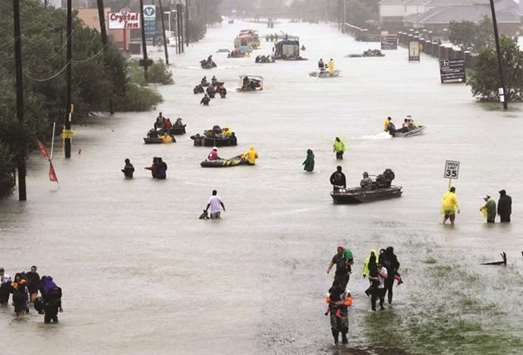The real scientists, not the fossil fuel industry shills, have been proven correct.
Rising atmospheric and sea temperatures brought about by the incessant production of environmentally destructive, heat-trapping greenhouse gases have ensured that what were called “500-year storms” are now happening every couple of years.
Hurricane Harvey saw areas of Texas never prone to flooding deluged with up to 50 inches of rain. Interstate highways were turned into raging rivers. The second floors of many homes and apartment buildings were reached by flood waters.
But the epochal flooding of Houston and several other areas of Texas do not represent a one-off event.
As Texas counted the dead and tallied up the billions of dollars in damage caused by Harvey, South Asia saw 1,200 deaths and millions of people made homeless by unusually powerful monsoon rains that left cities in Bangladesh, India, Nepal and Pakistan under water.
In July, unprecedented rains flooded subway stations and turned streets into lakes in Istanbul, one of Europe’s most populous cities. There’s no doubt about it: With drastic climate change, the world is experiencing historic storms more often.
Hurricane Katrina did to New Orleans and southern Louisiana in 2005 what Harvey did to Houston and surrounding environs this year – an entire metropolitan area was affected, and the impact will be long-lasting.
Hurricane Rita, which followed Katrina in 2005, served as a stark wake-up call for Houston, which was well-prepared for the wind event but could have never foreseen the floods wrought by Harvey.
Superstorm Sandy in 2012 put New York City on notice that it was not immune to the effects of climate change. Flooded subways and major Internet switching centres in Manhattan were a reality and not fodder for disaster movies.
The Carolinas were continuing to rebuild from 2016’s Hurricane Matthew unprecedented flooding when Harvey struck Texas.
Demands for assistance from such federal entities as the National Flood Insurance Programme reached new levels and put new stresses on the already in-debt flood relief fund.
The National Oceanic and Atmospheric Administration has counted an average of 15 named Atlantic storms each year from 1995 to 2012, an increase from years past. The frequency of the storms was directly attributed to warming oceans resulting from our warming atmosphere.
The simultaneous collapsing of ice formations in Antarctica and the Arctic will have irreversible effects on coastal flooding, sea currents and the abundance of marine life.
The collapse of marine ecosystems is already having disastrous results for species up and down the marine food chain. Eventually, the top of that food chain, humankind, will suffer from oceans devoid of sustaining food resources.
With Miami streets now flooding during non-storm-related tides, a Harvey-like storm striking Miami would leave permanent changes to the shorelines.
President Donald Trump calls climate change a Chinese-manufactured “hoax.”
Perhaps when the president’s Mar-a-Lago estate in Palm Beach, Florida, is inundated by the rising waters of the Atlantic Ocean, he might come to his senses about the realities behind global climate change and understand that his reliance on fake science has put more than his golfing and banquet buddies at risk.

With drastic climate change, the world is experiencing historic storms more often.


